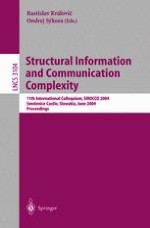2004 | Book
Structural Information and Communication Complexity
11th International Colloquium, SIROCCO 2004, Smolenice Castle, Slowakia, June 21-23, 2004. Proceedings
Editors: Ratislav Královic̆, Ondrej Sýkora
Publisher: Springer Berlin Heidelberg
Book Series : Lecture Notes in Computer Science
Included in: Professional Book Archive
